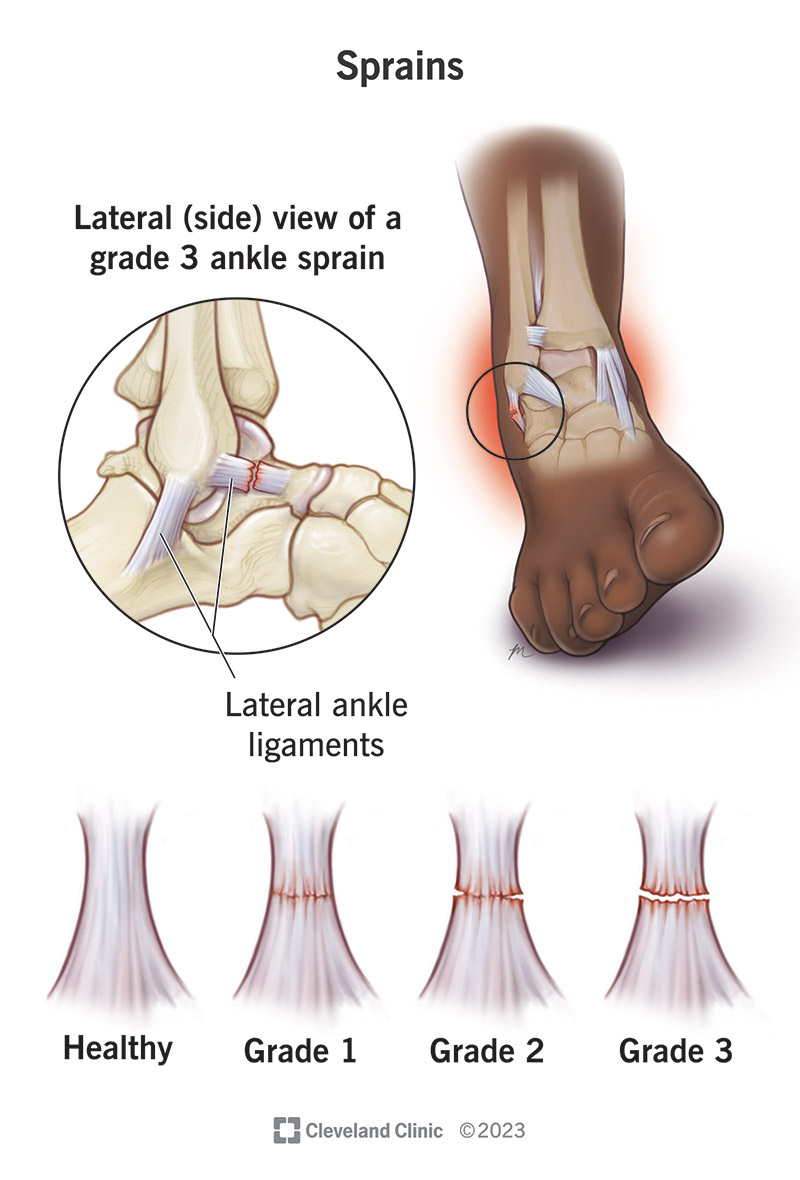Sprains are common injuries. They happen when ligaments around one of your joints are stretched or torn. Sport injuries and falls are the most common causes. You can usually manage your symptoms at home with the RICE method, but you should visit a healthcare provider to get any injury diagnosed.
Advertisement
Cleveland Clinic is a non-profit academic medical center. Advertising on our site helps support our mission. We do not endorse non-Cleveland Clinic products or services. Policy

A sprain is an injury that happens when one of your ligaments is stretched or torn.
Advertisement
Cleveland Clinic is a non-profit academic medical center. Advertising on our site helps support our mission. We do not endorse non-Cleveland Clinic products or services. Policy
Ligaments are bands of tissue that connect bones throughout your body. They’re like ropes that hold your muscles and bones together and prevent them from moving too far. Ligaments also make sure your joints only move in the direction(s) they’re supposed to.
Sprains happen when ligaments around one of your joints are damaged. Visit a healthcare provider if you notice pain, swelling or it’s hard to use or put weight on a joint — especially if you’ve experienced a fall, injury or accident.
Any joint supported by ligaments can be sprained. The most commonly sprained joints are:
Sprains are very common. They’re one of the most common injuries, especially among athletes.
The most common sprain symptoms include:
Anything that forces your joint to move too much or too far can cause a sprain. The most common causes include:
Advertisement
Anyone can experience a sprain, but some people are more likely to sprain a joint, including:
Exercise habits that can increase your injury risk (especially sprains) include:
A healthcare provider will diagnose a sprain with a physical exam. Your provider will examine your injured joint. Tell them when you first noticed symptoms, especially if you know exactly what caused the injury.
Healthcare providers grade sprains based on their severity:
You might need imaging tests to take pictures of your joint and the tissue around it. These tests can show damage inside your joint and help diagnose other injuries like bone fractures. Your provider might use:
After you see a provider for a diagnosis, you should be able to treat sprain symptoms at home by following the R.I.C.E. method:
Over-the-counter NSAIDs (aspirin or ibuprofen) or acetaminophen can reduce pain and inflammation. Talk to your provider before taking over-the-counter (OTC) pain medication for longer than 10 days.
Other treatments you may need include:
It’s rare to need surgery after a sprain. You may need surgery for a severe sprain or other injuries like a broken bone or dislocation. Some people need surgery if they’ve sprained the same joint multiple times.
Advertisement
You should start feeling better gradually after you start treating your symptoms. The most important part of healing after a sprain is to avoid using that joint or putting more stress on it. Ask your provider how much you can use your joint while you’re recovering.
You should expect to make a full recovery. Sprains are usually temporary injuries, and shouldn’t have a long-term impact on your health or ability to stay active.
Spraining a joint can make you more likely to injure it again in the future. Ask your provider about your unique risk and what you can do to prevent future sprains.
Your sprain recovery time will depend on which joint is sprained and how severe it was. Most sprains take a few weeks to heal. More severe (grade 3) sprains can take a few months. Your healthcare provider will tell you what to expect.
There might not be any way to prevent a sprain, especially if you’re an athlete.
During sports or other physical activities:
Advertisement
Follow these general safety tips to reduce your risk of an injury:
Visit a healthcare provider if you’ve experienced an injury and have sprain symptoms. Talk to your provider if you’ve started treating a sprain and your symptoms aren’t improving after a few days (or if they’re getting worse).
Go to the ER if you experience any of the following:
Sprains and strains are similar injuries — the difference is what’s damaged.
Sprains happen when a ligament is torn or damaged, usually when one of your joints moves further than it should.
Muscle strains happen when one of your muscles is torn. People also sometimes call strains pulled muscles or muscle tears. Providers sometimes call tendon tears strains.
Advertisement
Sprains and strains are both common sports injuries. Visit a healthcare provider if you’re experiencing pain, swelling and can’t move a joint or muscle as well as you usually can.
Almost everyone’s twisted an ankle, jammed a finger or had some kind of sprain in their lives. They’re one of the most common injuries. Even if most sprains aren’t serious and will heal with rest and at-home treatments, don’t ignore pain, swelling or instability in a joint. See a healthcare provider to get any injury diagnosed correctly, especially if it’s making it hard to use or move a joint.
From sudden injuries to chronic conditions, Cleveland Clinic’s orthopaedic providers can guide you through testing, treatment and beyond.

Last reviewed on 09/20/2023.
Learn more about the Health Library and our editorial process.